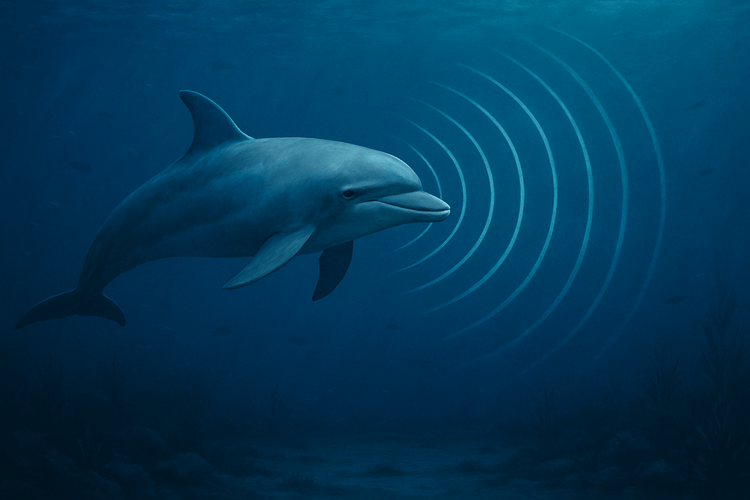Dolphin Sonar: Nature’s Impossible Engineering Marvel
Imagine navigating through pitch-black water, instantly mapping every detail of your surroundings with pinpoint accuracy. Picture “seeing” inside objects to determine their internal structure, density, and composition—all while moving at high speed through a three-dimensional maze of obstacles. This isn’t science fiction; it’s the everyday reality for dolphins and their biological sonar system.
While human submarines rely on clunky sonar equipment that struggle with basic object identification, dolphins effortlessly perform feats that leave our most advanced technology in the dust. The question that should fascinate every curious mind is this: How did undirected natural processes supposedly create engineering solutions that our brightest scientists still can’t replicate?
THE ASTOUNDING COMPLEXITY OF DOLPHIN ECHOLOCATION
Dolphin sonar operates on principles that would make any engineer envious:
Astounding sound frequency range: These marine mammals generate sounds ranging from 1 to 150 kilohertz—far beyond human hearing, which tops out around 20 kHz. But frequency range is just the beginning of this biological marvel.
The sound production system alone defies simple explanations. Dolphins create their sonar clicks using specialised structures called phonic lips, then focus these sounds through an organ called the melon—a lens-like structure filled with specialised fats that can change shape to adjust beam width and focus. It’s like having a built-in, adjustable acoustic spotlight.
Even more remarkable is the reception system. Sound waves bounce back and are received not through the ears, but through the dolphin’s lower jaw, which acts as a sophisticated acoustic antenna. These vibrations travel through specialised fats to the inner ear, where they’re processed by a brain that creates real-time, three-dimensional acoustic images.
The processing power required is staggering. Dolphins can distinguish between objects that differ by less than a millimetre, identify the internal structure of fish, and track multiple moving targets simultaneously—all while processing this information fast enough to navigate at speeds up to 25 mph. They can even “see” buried objects in sand, something that challenges our best ground-penetrating radar.
Here’s what makes this truly remarkable from a design perspective: every component must function perfectly from the start. A partially developed melon provides no evolutionary advantage. Phonic lips without proper brain processing are useless. The entire system represents what scientists call “irreducible complexity”—remove any part, and the whole system fails.
NATURE’S SONAR ALL-STARS
Dolphins aren’t alone in possessing these incredible abilities. Over 200 species of bats have independently developed echolocation systems, each precisely tuned to their hunting and navigation needs. Some use constant frequency calls, others frequency modulation, and many switch between modes depending on circumstances—like having multiple radar systems in one compact biological package.
Toothed whales showcase even more impressive capabilities. Sperm whales use biosonar to hunt in the crushing depths of ocean trenches, navigating environments where human technology would be instantly destroyed. Beaked whales perform similar feats, diving deeper than nuclear submarines while maintaining perfect acoustic awareness of their surroundings.
Perhaps most intriguingly, some shrews and birds also have developed echolocation abilities. This presents what evolutionary biologists call the “convergent evolution problem”—the same complex solution supposedly arising independently multiple times through random mutations. It’s like claiming multiple teams of blindfolded people could independently assemble identical Swiss watches by randomly moving the parts around.
WHEN BIOLOGY OUTPERFORMS TECHNOLOGY
The comparison between biological and human-engineered sonar systems reveals a humbling truth: nature’s solutions remain vastly superior to our best efforts. Military sonar systems require enormous amounts of power, sophisticated computer processing, and still struggle with basic tasks that dolphins perform effortlessly.
Take object identification. Our most advanced sonar can tell you something is there and roughly what shape it is. Dolphins can determine if it’s a fish, what species, whether it’s healthy or injured, and even its emotional state. They can distinguish between objects with 98% accuracy at distances where human sonar provides only fuzzy outlines.
Medical ultrasound technology, despite decades of refinement, can’t match the resolution and real-time processing capabilities found in dolphin biosonar. While our machines require computer analysis and trained technicians to interpret images, dolphins instantly process acoustic information into actionable intelligence.
Perhaps most telling is our ongoing attempts at biomimicry. Despite investing millions of dollars and decades of research into replicating dolphin sonar, our best efforts still fall dramatically short of biological performance. We’re essentially trying to reverse-engineer a system so sophisticated that we can barely comprehend its operating principles.
THE CHALLENGE FOR EVOLUTION
From an evolutionary standpoint, dolphin echolocation presents formidable challenges.
The fossil record shows no gradual development of sonar capabilities—these complex systems appear fully formed in the geological record, with no clear transitional forms showing intermediate stages of development.
Also consider what would be required for echolocation to evolve gradually. You’d need simultaneous mutations affecting brain architecture for sound processing, specialised anatomy for sound production and reception, and the behavioural programming to use these systems effectively. Each component is useless without the others, yet evolutionary theory requires each mutation to provide immediate survival advantages.
The mathematical challenges are equally daunting. Calculating the probability of the necessary genetic changes occurring in sequence reveals numbers so small that they exceed the probabilistic resources of the observable universe. Even given the billions of years evolutionary theory proposes, there simply isn’t enough time or opportunity for such complex, integrated systems to arise through undirected processes.
THE MAMMALIAN MARINE MARVEL
In addition to their extraordinary sonar capabilities, dolphins present another design puzzle that compounds the evolutionary challenge. They’re mammals—warm-blooded, air-breathing creatures with lungs, not gills—that have somehow mastered life in an environment seemingly designed for fish.
Consider the engineering marvels required: dolphins maintain constant body temperature in water that conducts heat 25 times faster than air, requiring sophisticated insulation and circulatory adaptations. They must surface regularly to breathe while living permanently underwater, necessitating behavioural and physiological systems that coordinate diving, breath-holding, and oxygen conservation. Female dolphins give birth to live young underwater and nurse them with milk—imagine the mechanical challenges of underwater delivery and feeding systems that work in a liquid environment.
Each of these mammalian characteristics presents its own irreducible complexity. A partially warm-blooded animal gains no survival advantage. Lungs that work only occasionally underwater provide no evolutionary benefit over the gills that supposedly preceded them. The simultaneous coordination required for underwater birth, milk production, and calf survival demands multiple integrated systems functioning flawlessly from the start.
THE DESIGN INFERENCE
Friend, consider this: dolphins aren’t just remarkable for one sophisticated system, but represent multiple integrated marvels—advanced biosonar, warm-blooded physiology in cold water, air-breathing in an aquatic environment, underwater birth and nursing—it paints a picture of engineering solutions that work together seamlessly at every level.
It’s that kind of multi-layered complexity and integration that makes the design perspective so compelling. Each system is remarkable on its own, but the way they all coordinate perfectly in one creature really does suggest intentional, intelligent engineering rather than step-by-step accidental development.
When we encounter sophisticated engineering solutions in human technology, we immediately recognise the hallmarks of intelligence: purposeful arrangement of parts, integration of multiple systems serving a common function, and optimisation for specific tasks. Dolphin sonar exhibits all these characteristics in spades.
DOLPHIN SONAR: NATURE’S ENGINEERING MARVEL—RELATED FAQs
What is evolution’s best explanation for how dolphin sonar developed? Evolutionary biologists propose echolocation evolved gradually through a process called “pre-adaptation,” where structures originally used for communication were gradually repurposed for navigation. They suggest early cetaceans—aquatic mammals such as whales and dolphins—may have used simple vocalisations to maintain group contact in murky water, and natural selection gradually refined these abilities into sophisticated biosonar. However, this explanation struggles to account for the simultaneous development of all necessary anatomical structures and the complex neural processing required. The fossil record also lacks clear intermediate forms showing this gradual progression.
- Is it true dolphins can actually “see” with sound better than we see with light? Indeed, in many ways, yes. Dolphin echolocation provides information that vision cannot, such as the internal structure and density of objects. They can detect air-filled swim bladders inside fish, identify hollow versus solid objects, and even “see through” sand to locate buried creatures. Their acoustic imaging works equally well in complete darkness, murky water, or crystal-clear conditions. While human vision excels at detecting surface details and colours, dolphin sonar reveals three-dimensional structure and material properties that remain invisible to our eyes.
- How do dolphins avoid interfering with each other’s sonar even when swimming in groups? Dolphins employ sophisticated “acoustic etiquette” that prevents jamming between individuals. Each dolphin can adjust its click frequency, timing, and beam direction to avoid interference with pod members. They also have remarkable ability to distinguish their own echoes from those of nearby dolphins, similar to how we can pick out our own voice in a crowded room. Some species even take turns clicking when hunting cooperatively, demonstrating a level of acoustic coordination that suggests intentional communication protocols.
What’s the most impressive dolphin sonar feat on record? Military researchers documented dolphins successfully locating mines buried three feet deep in ocean sediment—a task that defeats most human-designed metal detectors. In captivity, dolphins have identified the thickness of aluminium plates to within fractions of an inch and detected small objects inside opaque containers. Perhaps most remarkably, they can echolocate individual fish within dense schools, tracking specific targets while ignoring hundreds of similar-sized decoys swimming nearby.
- Are there any downsides or limitations to biological sonar? Dolphin echolocation does have some constraints compared to human technology. Their range is limited to roughly 100-150 meters in optimal conditions, far less than military sonar systems. The system also requires significant energy expenditure, and dolphins must actively vocalise to “see,” whereas our eyes passively collect light. Additionally, very soft objects or those that perfectly match the acoustic properties of water can sometimes evade detection, though dolphins have learned to compensate for these limitations through behavioural adaptations.
- How do baby dolphins learn to use echolocation? Dolphin calves begin producing clicks within days of birth, but mastering echolocation takes months of practice and learning. Mothers appear to actively teach their young, positioning themselves to provide acoustic “training targets” and adjusting their own clicking patterns to help calves understand echo interpretation. The learning process involves both instinctive behaviours and cultural transmission, suggesting that while the hardware is built-in, the software requires education—much like human children learning to interpret visual information.
Will we ever develop artificial sonar that matches dolphin capabilities? Despite decades of research and millions in funding, human engineers have yet to create artificial sonar systems that match dolphin performance in real-world conditions. The challenge isn’t just technological but also computational—dolphins process acoustic information using biological neural networks that operate on principles we don’t fully understand. Current biomimetic efforts have produced some improvements in underwater robotics, but we remain far from replicating the integration, efficiency, and real-time processing capabilities found in biological systems. The gap between human engineering and biological sonar continues to widen as we discover new capabilities in dolphin echolocation.
DOLPHIN SONAR: NATURE’S ENGINEERING MARVEL—OUR RELATED POSTS
- The Gecko’s Nanoscale Feet: Defying Both Gravity and Evolution
- The Emperor Penguin: Designed to Thrive in Extreme Climates
- The Pelican: Precision-Engineered Fishing Vessel
- Explosive Evidence: How the Bombardier Beetle Demolishes Darwinism
- Nature’s Puzzle: The Platypus as Evidence of Divine Engineering
- Bats: How Nature’s Flying Marvels Defy Evolution
- Tadpole to Frog: How Metamorphosis Reveals Divine Programming
- Honeybees: 5 Ways Nature’s Unsung Architects Point to the Creator
- Testament to Design: The Engineering Marvel of Elephants
- Blue Whales: Mammoth Icons of Intelligent Design
- The Woodpecker’s Design: How Nature’s Headbanger Defies Evolution
- Too Perfect to Be Random: The Giraffe’s Remarkable Design
Editor’s Pick

Gender Reassignment: Can Christian Doctors Perform These Surgeries?
In the quiet of a clinic, a Christian physician faces a challenging ethical question. A patient sits across the desk, [...]

‘What Sorrow Awaits You Who Are Rich…’: What Does Jesus Mean?
The words hang in the air like a sword over comfortable Christianity: “What sorrow awaits you who are rich, for [...]

Does the Bible Clearly Teach the Deity of Christ?
Critics argue Jesus never explicitly claimed to be God. Others suggest the doctrine emerged centuries later through philosophical speculation. But [...]

The Holy Spirit’s Indwelling: How Can I Be Sure I Have It?
“Am I truly saved? How can I know for certain that the Holy Spirit lives within me?” If you’ve wrestled [...]

Did Mary Remain a Virgin? A Biblical Case Against Perpetual Virginity
The question of Mary’s perpetual virginity has divided Christians for centuries. While Catholic and Orthodox traditions affirm Mary remained a [...]

Is Occam’s Razor a Compelling Argument Against Theism?
WHY THE ARGUMENT ACTUALLY POINTS TO GOD Picture this: You're in a coffee shop debate with a confident sceptic [...]

Is the Doctrine of Justification in the Old Testament?
WAS PAUL INVENTING SOMETHING NEW OR REVEALING SOMETHING ANCIENT? Picture this scene: You’re discussing faith with a thoughtful sceptic who [...]

How God Reveals Himself to Us: General and Special Revelation
Every human heart carries an undeniable longing to know ultimate truth—to understand our place in the universe and the longing [...]

Doctrine of God and Bible Interpretation: Are The Two Connected?
Picture this: Two seasoned pastors read the same verse about God's sovereignty and human responsibility. One concludes God determines all [...]

What Did Jesus Mean: ‘I Bring Not Peace But a Sword’?
Jesus’ statement may sound perplexing to us at first read: "Do not think that I have come to bring peace [...]





